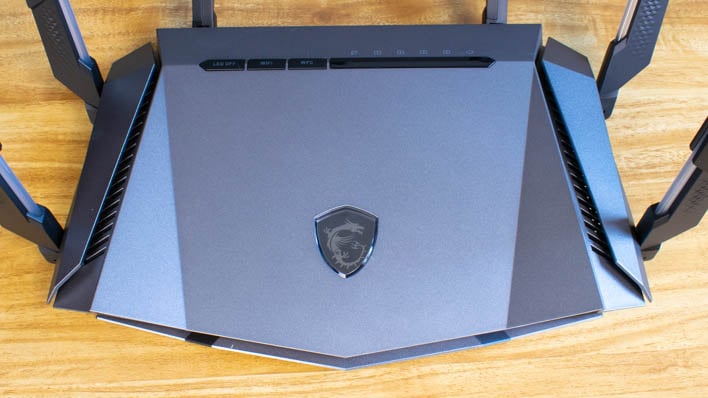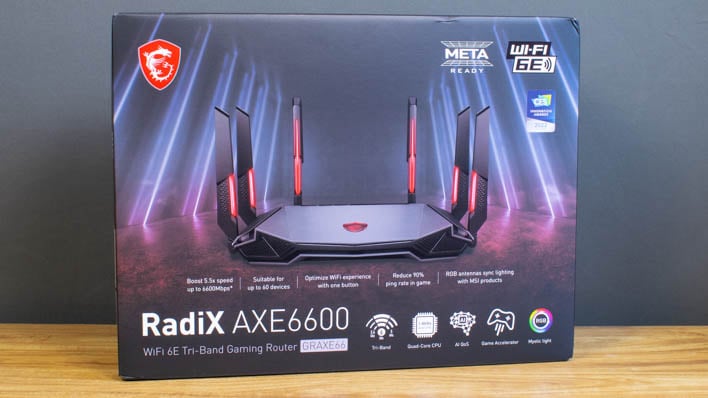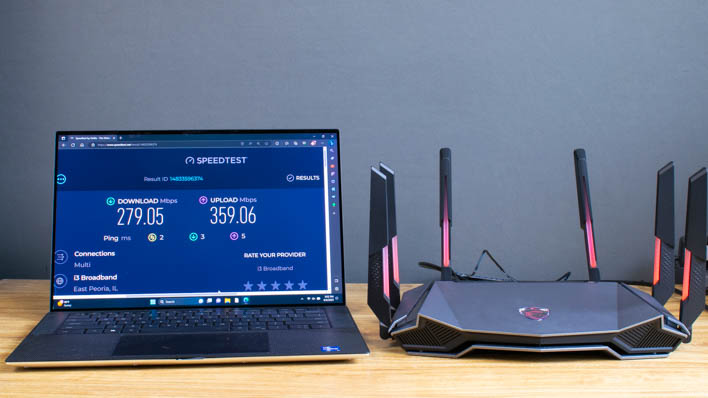MSI RadiX AXE6600 Gaming Router Review: Speedy Wi-Fi 6E Networking
MSI RadIX AXE6600 Wi-Fi 6E Router: Wireless Performance and Conclusions
As we mentioned, Wi-Fi 6E utilizes three different frequency bands: 2.4 GHz, 5 GHz, and 6 GHz. We'll be testing all three of these bands on the MSI RadiX AXE6600 with two two Wi-Fi 6E-capable laptops, the 2023 MacBook Pro 14" and the latest generation Dell XPS 15 9530. We're transfering files between the two laptops via Wi-Fi, and we'll also transfer files to a desktop machine with a 2.5 Gigabit Ethernet port over the RadiX AXE6600's 2.5 Gigabit port. This should give us a good feel for how the router can handle everything. We can also test each band individually, since we could give different SSIDs to the 2.4 GHz and 5/6 GHz networks, and toggle 6 GHz independently.
Our Test Methodology
We're also doing some crowded network testing, too. No modern home has just two Wi-Fi devices. There are smart TVs, streaming boxes, tablets, and smartphones to consider. So while we're reporting speeds on this router, we're allowing other devices to connect. This is, in our opinion, the only way to test. In a typical household of four, there are typically four phones and two Apple TV or other streaming boxes, along with one other laptop and an iPad. These devices all sat idle while we tested, and we ran each test a minimum of three times, discarding the highest and lowest performance. MSI says the RadiX AXE6600 can manage upwards of 60 Wi-Fi devices, and our test house had nowhere near that number.MSI RadiX AXE6600 Performance Testing
To test Wi-Fi performance, we used three distances. The closest is about five feet, and in the same room as the router. The next is two rooms away at a distance of about 20 feet, and the third is on the far opposite corner of the house, with a direct-line distance of approximately 35 feet. Let's start with wireless-to-wired transfers, which will likely be the fastest of our bunch. Our transfer test is a single 26-gigabyte HVEC 4K video file, which should allow the machines to hit their highest sustained transfer speeds. We timed it with a stopwatch and then converted the result to megabytes per second.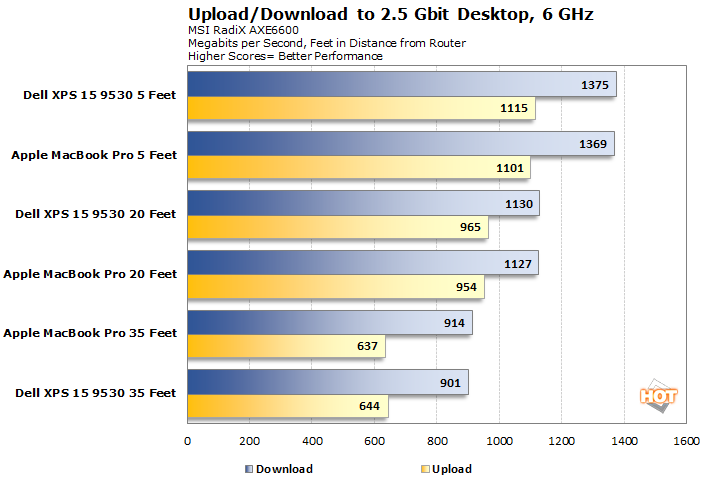

Note that the measurements above are megabits per second, not megabytes. A megabyte is eight times as large as a megabit, so we can do the conversion easily enough if you want to think of it in terms of how Windows would report transfer speeds. As we can see, neither laptop really achieved anything close to 2.5 Gbit per second over the air to the wire, but we did get up over 1 Gbit on both laptops with the 6 GHz band. Uploads lag behind a bit at all three distances, however.
When we get to wireless-to-wireless transfers, the aggregate throughput is actually higher even though the values here are lower, and that's because traffic is always going both ways. We're getting over 2.1 Gbps between the two machines when they're both sitting five feet from the router, but just over half that once we the distance extends to 35 feet. This is actually pretty decent coverage, all things considered.
One issue we feel like we need to point out here is that distance matters with 5 GHz and 6 GHz networks. It's less apparent in the medium 20-foot distance, but at 35 feet, you really do feel that speed difference. The solution to this is a mesh network, but as we mentioned earlier, the MSI RadiX AXE6600 does not have any sort of mesh software component. Our reference home network is a pair of ASUS RT-AX3000 routers (which recently had an important security update) using AI Mesh and the same spot that's 35 feet from the router is only about 12-15 feet from a second access point in the living room, bonded by a 1 Gbps Ethernet backhaul. That gives our home network much more coverage at higher speeds, and our older routers are actually much faster in that spot in the house as a result.
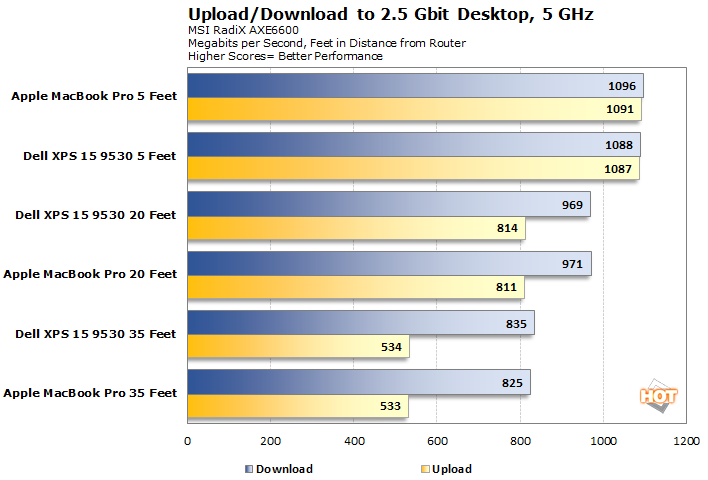
Transfers at 5 GHz didn't do too shabby, either. At a distance of five feet, and again at around 20 feet, we pushed up over 110 megabytes per second, working out to around 900 megabits. It's only when we hit 35 feet, which is going through several walls, did we see the speed sag down to around 80 megabytes per second, which still works out to around 650 megabits. This is far more than enough to saturate most home internet connections, and more often than not, it's plenty for LAN transfers, too. In a bubble these numbers are "large" to be certain, but what does it look like against a last-generation router? For that, we have our ASUS RT-AX3000 setup. Remember, we're using dual routers, so for these tests we turned one of them off. It's apples-to-apples comparisons here without any mesh Wi-Fi setups.
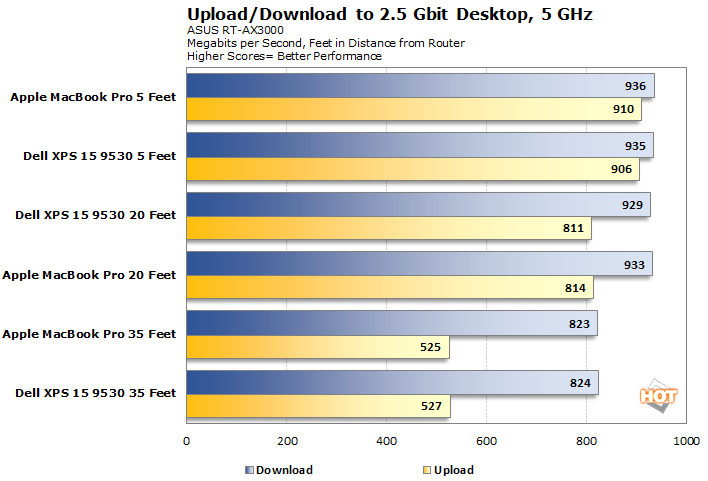
The first obvious difference is that we don't top 1 Gigabit, and that's because the ASUS router only has a gigabit connection without any 2.5 Gbps ports. All the same, the 5 GHz performance is similar to the RadiX AXE6600, so the benefit of upgrading to a new Wi-Fi 6E router is solely in the 6 GHz coverage, at least against this model. Cheaper models might also have more to gain in this band, but not here.
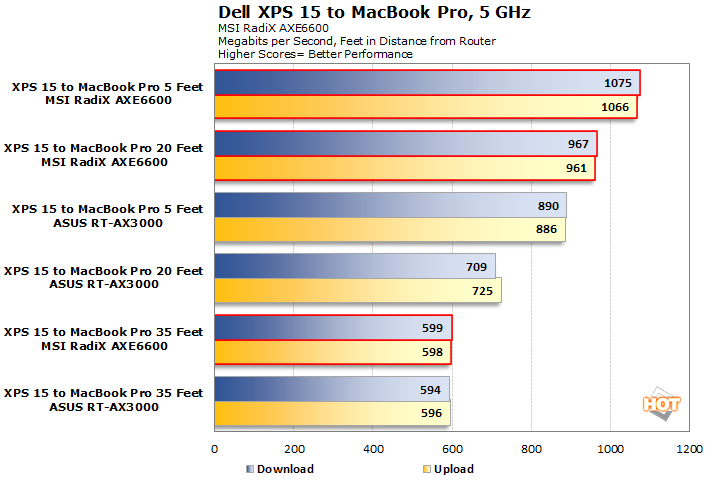
When we switch to wireless-to-wireless transfers and put all our routers on one chart, we can see that wireless-to-wireless transfers favor the MSI RadiX router pretty heavily. At both five feet and 20 feet, the RadiX AXE6600 outperformed the older Wi-Fi 6 ASUS router by a good margin, so much so that the 20-foot distance with the RadiX is still better than the RT-AX3000 at five feet. When we get to 35 feet away, the advantage is all but evaporated, which makes us again kind of long for a mesh setup. The RadiX AXE6600 can be put in access point mode by turning off DHCP and allowing other routers to govern it, but the load balancing and automatic switching features of more mature mesh setups isn't present in this mode.

If you absolutely need the distance of a 2.4 GHz network, or have some older 802.11n/g devices that need to use the 2.4 GHz band, it's functional, but the performance is drastically reduced, even when going to a wired connection. This chart proves it's functional, though, and it's plenty for something like a smart speaker playing music and doing simple web searches, or home automation devices like light bulbs and thermostats, and that's fine.
MSI RadiX AXE6600 Review Conclusions
The MSI RadiX AXE6600 is a very nice home router, all things considered. It boasts 2.5 Gigabit Ethernet, either for super-fast internet connections or faster networking in the home. Having a single 2.5 Gbit port is a bit of a downside, but adding on a 2.5 Gbit switch will still let the router run a really fast internal network. But the wireless network is meant to be the star of the show, and it acquitted itself pretty nicely. The 6600 in its name implies that it can handle upwards of 6.6 Gigabits per second on the wireless networks across the various supported bands, but that's aggregate; no single device will never pull that much on its own, but in our own testing we could see that two were definitely faster than one.The RadiX AXE6600's software features are solid, as well. There's content filtering, guest Wi-Fi access, and a host of gaming and streaming-specific software tweaks that can help users get the most out of their internet connections. The unique MSI-focused QoS features might also be useful to folks who have other devices from the manufacturer, too. While the LED lighting is neat, it's completely optional and folks who don't want to use it can turn it off. Software support is solid, too. During our testing, MSI released not one but two updates a few weeks apart, so the company seems to be committed to keeping up with security patches and other fixes.
Unfortunately, there is a downside to the software in its current state. For smaller homes or apartments, the router is pretty much ideal. Anywhere that you can more-or-less centrally locate a router, you'll have great coverage up to a couple thousand square feet. In large homes or where there are a lot of walls, however, having a mesh setup would be preferrable. Our house is L-shaped due to construction to add on new rooms a couple years ago, and the fiber internet connection comes into the house as far away from that area as humanly possible. As a result, the coverage can fall off around the edges. This is just something to be aware of if you're trying to cover a large area, whether it's a house or an office space. If the internet connection was more in the center of the house, we'd have had better coverage, but it is what it is.
For the majority of renters and homeowners, this single router provides three bands of Wi-Fi coverage and pretty darn fast wired network capabilities. Its asking price is a little steep, at around $349 direct from MSI. However, the going price is more like $285 on Amazon, and for that price it offers strong performance and features comparable to a lot of other routers in its class. For that reason, we can easily recommend the MSI RadiX AXE6600.


